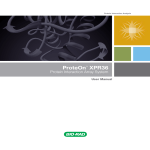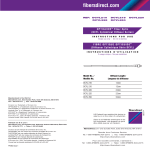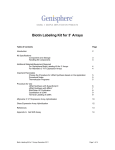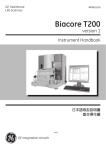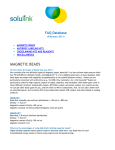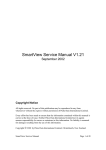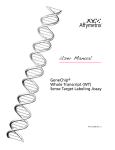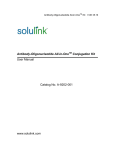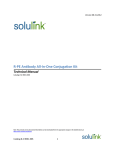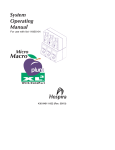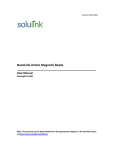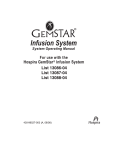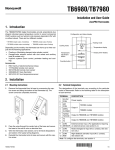Download - Bio-Rad
Transcript
ProteOn Sensor Chips ProteOn™ Sensor Chips Tips and Techniques Contents ProteOn Sensor Chips 1 Storing Sensor Chips Opening a Sensor Chip Initializing a Sensor Chip Setting Up a Protocol 2 3 3 3 Running Experiments with Sensor Chips 4 Conditioning Chips Ligand Immobilization Desired Ligand Immobilization Level Optimizing Immobilization Conditions GLX Sensor Chips Activation Ligand Immobilization Deactivation NLC Sensor Chip Ligand Capture HTX Sensor Chips Activation and Ligand Capture LCP Sensor Chip and Liposome Capturing Kit Activation, Conditioning, and Liposome Capture GLC Lipid Kit Surface Modification Partial Surface Modification Liposome Capture Troubleshooting Ligand Immobilization Amine Coupling with GLX Chips Typical Ligand Buffer Conditions Activation Quality Ligand Activity Ligand Capture with the NLC Chip Stabilization Analyte Injection Troubleshooting Analyte Injection Nonspecific Binding Electrostatic NSB Non-Electrostatic NSB Techniques for Reducing or Eliminating NSB on All Sensor Chips Bulk Effect Correcting for Bulk Effect Bubble Formation Tips for Reducing Bubble Formation Regeneration GLX and NLC Sensor Chips HTX Sensor Chips LCP Chip and Liposome Capturing Kit GLC Lipid Kit Ordering Information Related Literature 4 5 5 5 6 6 6 7 7 7 7 7 8 8 8 8 9 9 10 10 10 10 10 11 12 12 13 13 14 15 15 17 17 17 17 18 18 18 19 19 20 2121 ProteOn Sensor Chips All ProteOn sensor chips are designed for use with the ProteOn XPR36 protein interaction array system. Each sensor chip is a gold-coated glass prism containing surface chemistry used for the immobilization of biomolecules (ligands) to the chip surface. This enables interactions with other biomolecules (analytes) to create a measurable SPR response used in kinetic analysis and other applications. Refer to bulletin 5404 for details on the surface chemistry of each chip. For more information about the ProteOn instrument and instructions for running experiments, see the ProteOn XPR36 protein interaction array system user manual (part number 10021411). ProteOn Sensor Chips The ProteOn family of chips features outstanding performance in kinetic analysis, high binding capacities, high sensitivity for the detection of low molecular weight analytes, uniform spot-to-spot response, minimal baseline drift, bar codes, and long-term storage stability. Each ProteOn sensor chip is suitable for particular applications, including the following: ■■ ■■ ■■ ■■ ■■ ■■ ■■ ProteOn GLC sensor chip — for protein-protein interaction analysis roteOn GLM sensor chip — for protein–small molecule and protein-protein P interaction analysis ProteOn GLH sensor chip — for protein–small molecule interaction analysis roteOn NLC sensor chip — for DNA-protein and protein-protein P interaction analysis roteOn HTG sensor chip — for protein-protein and protein-peptide P interaction analysis ProteOn HTE sensor chip — for protein–small molecule interaction analysis roteOn LCP sensor chip — for capturing lipid assemblies for lipid-protein, P lipid–small molecule, and membrane protein–protein interaction analysis The sensor chip cartridge label contains the following information: Expiration date Bar code Chip type Catalog number Storing Sensor Chips Store chips at 4°C. To avoid condensation on the chip surface, which can lead to inaccurate results, keep sensor chips in the sealed nitrogen-filled pouch during storage. Sensor chips should also remain in the pouch until reaching room temperature before use. Temperature equilibration takes from 30 to 60 min. 2 Opening a Sensor Chip 1. After temperature equilibration, cut the top seal of the aluminum pouch. 2. Hold the black end of the cartridge up inside the pouch to ensure the sensor chip slide remains inside the cartridge. 3. Press the sensor chip slide firmly into place within the cartridge. 4. Remove the sensor chip cartridge from the aluminum pouch. Sensor chip slide Cartridge Initializing a Sensor Chip New sensor chips must be initialized in the instrument the first time they are used in an experiment. Follow these steps to initialize the sensor chip, using either air or glycerol. 1. Insert the temperature-equilibrated sensor chip into the instrument chip loader. The chip ID, chip chemistry, and chip expiration date populate the Chip Details area of the Sensor Chip box in the ProteOn Manager™ software. 2. Choose one of the initialization options, using either air or glycerol. 3. The additional Use Last initialization option is available for reuse of the sensor chip. If the used sensor chip is taken out and reinserted in the instrument, glycerol initialization must be used. Setting Up a Protocol 1. Choose New or Open from the menu bar to open the database browser. 2. Choose a Template, Protocol, or Experiment. Edit the name as needed for your new experiment. 3. In the Protocol screen, edit the configuration, samples, and protocol steps as needed. 4. In the Instrument Control screen, set the chip temperature and sample temperature. 3 Running Experiments with Sensor Chips An interaction analysis experiment comprises five major steps: 1. Conditioning 2. Ligand immobilization 3. Stabilization 4. Analyte injection 5. Regeneration Conditioning Chips Conditioning prepares the chip surface for use. Although optional, it is highly recommended because it can increase baseline stability. The conditioning protocols for all sensor chips are listed in Table 1. Table 1. Conditioning parameters. GLC, GLM, and GLH Chips Injection 1 2 3 4 5 6 Reagent Orientation Volume, µl Flow Rate, µl/min 0.5% SDS 50 mM NaOH 100 mM HCl 0.5% SDS 50 mM NaOH 100 mM HCl Horizontal Horizontal Horizontal Vertical Vertical Vertical 30 30 30 30 30 30 30 30 30 30 30 30 Reagent Orientation Volume, µl Flow Rate, µl/min 50 mM NaOH 1 M NaCl 50 mM NaOH 1 M NaCl Horizontal Horizontal Vertical Vertical 30 30 30 30 30 30 30 30 Reagent Orientation Volume, µl Flow Rate, µl/min 0.5% SDS 50 mM NaOH 100 mM HCl 300 mM EDTA 0.5% SDS 50 mM NaOH 100 mM HCl 300 mM EDTA Horizontal Horizontal Horizontal Horizontal Vertical Vertical Vertical Vertical 30 30 30 30 30 30 30 30 30 30 30 30 30 30 30 30 NLC Chip Injection 1 2 3 4 HTG and HTE Chips Injection 1 2 3 4 5 6 7 8 Note: 1. In conditioning, we recommend using the same buffer used for running experiments. When working with buffers containing metal ions that form hydroxide precipitates, however, eliminate the NaOH injections. 2. Trehalose is used as a protective layer for the dry NeutrAvidin on the NLC chip surface. It will be completely removed by continuous buffer flow over the chip surface. However, conditioning is highly recommended to ensure complete removal of the protective layer. 3. For the LCP chip used with the ProteOn liposome capturing kit, perform conditioning after biotin-ssDNA capture and before liposome capture. For the GLC chip used with the ProteOn GLC lipid kit, perform conditioning after surface modification and before liposome capture. Refer to the Ligand Immobilization section for more details. 4 Ligand Immobilization Ligand immobilization refers to the attachment of a ligand to the chip surface either by irreversible covalent bonding or by reversible capturing using a capture agent. Refer to bulletin 5821 for details on achieving optimal ligand immobilization. Desired Ligand Immobilization Level The immobilization level (RL), or amount of ligand immobilized on the chip surface, should be determined. The desired immobilization level is calculated using the following equation: Rmax = n MA ML RL Rmax is the desired maximum response when the ligand interacts with an analyte, MA is the molecular weight of the analyte, ML is the molecular weight of the ligand, and n is the stoichiometric coefficient of the interaction (the analyte/ligand ratio). For kinetic analysis, aiming for an analyte response with Rmax ≤200 RU is recommended. The approximate capacity of the amine coupling (GLX) chips, the biotin-capturing (NLC) chip, and the histidine tag– capturing (HTX) chips is as follows: GLC ~8 kRU GLM ~12 kRU NLC ~2 kRU HTG ~5 kRU GLH ~20 kRU HTE ~12 kRU Optimizing Immobilization Conditions In the ProteOn system, the experimental conditions can be conveniently optimized by injecting reagents across multiple channels with each channel having different conditions, for example, varied concentrations of ligand and analyte. 5 GLX Sensor Chips Activation When using the amine coupling or GLX chips, mix EDAC (1-ethyl-3-(3-dimethylaminopropyl)carbodiimide hydrochloride) and sulfo-NHS (N-hydroxysulfosuccinimide) to produce the activation solution. The activation reagents are typically prepared as a mixture of 1x EDAC/sulfo-NHS and should be mixed immediately before the injection. We recommend using a contact time of 60 sec for moderate activation and 300 sec for high activation levels. For the GLH chip, avoid using a high activation level because it can lead to overactivation and subsequent multivalent linking of the ligand. It is possible to eliminate the manual mixing of the activation reagents by using the Co-inject function of the ProteOn system. Refer to the article “Ligand Immobilization in Protein Interaction Studies – An Unattended Amine Coupling Protocol with Automatic Co-Injection Activation” in the May 2012 online issue of BioRadiations. Note: 1x EDAC/sulfo-NHS contains a 1:1 mixture of EDAC and sulfo-NHS, components that are included with the ProteOn amine coupling kit. We recommend following the instructions shipped with the kit to prepare the activation reagents. The final concentrations of the activation reagents are 20 mM EDAC and 5 mM sulfo-NHS. Ligand Immobilization We recommend preparing the ligand in a concentration range of 0.5 µg/ml to 25 µg/ml. Typically, using a slow flow rate of 30 µl/min is suggested to reduce ligand use during ligand injection; the contact time may vary from 1 min to over 10 min, depending on the immobilization level needed. The ligand coupling buffer is ~1 pH unit lower than the ligand pI to facilitate charge attraction between the positive ligand and the negative chip surface. Low ionic strength is also required to enhance charge attraction. These conditions provide a starting point for further optimizing experimental conditions. To achieve the desired immobilization level, choose from the two following approaches: 1. Set two consecutive ligand injection steps with a pause step in between. The first ligand injection step is short and measures the ligand immobilization rate. You may fine-tune the second ligand injection according to the ligand immobilization rate at the pause step to achieve the desired immobilization level. 2. Set a single long ligand injection step and monitor the ligand immobilization process. When the desired immobilization level is reached, hit the Abor t button to end the ligand injection step. 6 Deactivation Deactivation uses 1 M ethanolamine HCl at pH 8.5 to block any remaining activated carboxyl group on the chip surface. It is performed in the vertical direction, the same direction as the activation and ligand immobilization injections. NLC Sensor Chip Ligand Capture We recommend preparing the ligand in a concentration range of 0.5 µg/ml to 25 µg/ml. Typically, using a slow flow rate of 30 µl/min is suggested to reduce ligand use during ligand injection; the contact time may vary from 1 min to over 10 min depending on the immobilization level needed. These conditions provide a starting point for further optimization of experimental conditions. Note: The NLC chip does not need activation, and deactivation with biotin is optional. HTX Sensor Chips Activation and Ligand Capture Refer to the product insert included with the HTG and HTE reagent kit for details on how to use this kit (part number 10021524). When using the histidine tag–capturing chips or HTX chips, we recommend preparing the ligand in a concentration range of 0.5 µg/ml to 25 µg/ml and using a slow flow rate of 30 µl/min for the ligand injection to reduce ligand use. The contact time may vary from 1 min to over 10 min depending on the immobilization level needed. These conditions provide a starting point for the further optimization of experimental conditions. Perform ligand injection immediately after the activation step to avoid nickel (II) ion leakage and consequently a reduced immobilization level. Table 2. HTX chip activation and ligand capture parameters. Injection 1 2 Reagent Orientation Volume, µl Flow Rate, µl/min Vertical 10 mM NiSO4 0.5–25 µg/ml ligand Vertical 60 Flexible 30 30 The ProteOn HTG and HTE sensor chips are designed to capture histidine-tagged proteins directly from crude media and purified proteins. When capturing ligand from crude samples, dilute the ligand sample before the capture to reduce nonspecific binding. We recommend performing a significant dilution (for example, by 100-fold), depending on the amount of active ligand in the sample. Refer to bulletin 6302 for more detailed techniques to reduce nonspecific binding. Note: The HTG and HTE chips require activation but not deactivation. Ligand injection should be performed immediately after the activation step to avoid nickel (II) ion leakage and consequently a reduced binding level. 7 LCP Sensor Chip and Liposome Capturing Kit Refer to the product insert of the liposome capturing kit for details on how to use this kit (part number 10024332). Activation, Conditioning, and Liposome Capture Inject the biotin-ssDNA solution for surface activation. Then precondition the chip surface with the lipid modification conditioning solution (20 mM CHAPS) before liposome capture. Next, inject the chol-dsDNA 1 tagged liposome solution. If an additional liposome layer is needed, inject the chol-dsDNA 2 solution (0.4 µM) and allow the signal to stabilize for 5 min: then inject the chol-dsDNA 1 tagged liposome solution. Repeat this step to form multiple liposome layers. Table 3. LCP chip activation, conditioning, and liposome capture parameters. Injection 1 2 3 4 5 Reagent Orientation Volume, µl Flow Rate, µl/min 1.3 µM biotin-ssDNA 20 mM CHAPS 1 mg/ml chol-dsDNA 1 tagged liposomes 0.4 µM chol-dsDNA 2 1 mg/ml chol-dsDNA 1 tagged liposomes Vertical Vertical Vertical 50 150 150 30 30 30 Vertical Vertical 50 150 30 30 Note: Injections 4 and 5 are optional. GLC Lipid Kit Refer to the product insert of the GLC lipid kit for details on how to use this kit (part number 10023826). Surface Modification Use the activation and deactivation reagents from the ProteOn amine coupling kit. Inject 1x EDAC/sulfo-NHS, lipid modification solution, and 1 M ethanolamine HCl sequentially. Table 4. GLC surface modification parameters. Injection 1 2 3 Reagent 1x EDAC/sulfo-NHS 4.6 mM alkylamine 1 M ethanolamine HCl Orientation Volume, µl Flow Rate, µl/min Vertical Vertical Vertical 150 150 150 30 30 30 Note: 1x EDAC/sulfo-NHS contains a 1:1 mixture of EDAC and sulfo-NHS. These components are included with the ProteOn amine coupling kit. We recommend following the instructions shipped with the kit to prepare the activation reagents for this protocol. The final concentrations of the activation reagents are 20 mM EDAC and 5 mM sulfo-NHS. 8 Partial Surface Modification The extent of surface modification can be used to control the liposome capturing level and configuration. Lower surface modification will reduce the capturing capacity and in many cases improve the resistance to nonspecific binding. Lower modification will also increase the chances of capturing intact liposomes, while higher modification will increase the tendency of liposomes to deform and even open into lipid bilayers spread over the surface. Partial surface modification refers to varying the immobilization level of undecylamine by controlling the immobilization conditions. This can be achieved by controlling the activation level, undecylamine concentration, or injection volume. Otherwise, mixing undecylamine with ethanolamine HCI (the deactivation solution from the amine coupling kit) is an easy-to-use and efficient alternative. For fine-tuned control of the surface modification level, we recommend varying the undecylamine concentration by diluting the lipid modification solution (undecylamine) in the lipid modification conditioning solution (CHAPS). Liposome Capture Before liposome capture, condition the chip surface with the lipid modification conditioning solution (20 mM CHAPS), and then inject the liposome solution. Table 5. Liposome capture parameters. Injection 1 2 Reagent 20 mM CHAPS 1 mg/ml liposomes Orientation Volume, µl Flow Rate, µl/min Vertical Vertical 150 150 30 30 When injecting ligand, concentrations between 0.5 and 25 μg/ml are typically used with a flow rate of 30 μl/min and a contact time of 1 to 14 min. These conditions will produce signals of up to 5,000 RU on the HTG chip and 12,000 RU on the HTE chip. Please note that when capturing ligands from crude media, various other proteins may also be adsorbed to the chip surface, mainly due to nonspecific interaction with nickel (II) ions. Fortunately, these proteins will not interfere with the kinetics because ligand-analyte interactions are specific. However, the presence of nonspecifically bound lysate proteins will make accurate determination of ligand binding levels difficult given that the observed signal is the sum of the ligand signal and the signal from other bound proteins. 9 Troubleshooting Ligand Immobilization Amine Coupling with GLX Chips The degree of success in ligand immobilization can be visualized by observing the sensorgram during the procedure (see Figure 1). Typical Ligand Buffer Conditions The typical ligand buffer conditions are listed below: 1. The pH should be one unit below the pI value. 2. T he ligand buffer ionic strength should be low, and the ligand concentration should be above 0.1 μg/ml. 3. If a disulfide bond reduction reagent is needed in the ligand buffer, TCEP is preferred over DTT because TCEP is compatible with the amine coupling protocol. Response, RU A B 20,000 Deactivation 15,000 10,000 0 –5,000 –200 8,200 Immobilization Deactivation 19,400 13,800 Activation 5,000 25,000 Activation Immobilization 2,600 –3,000 0 500 Time, sec 1000 1,500 –200 180 560 940 1,3201,700 Time, sec Fig. 1. Sensorgram examples of failed (A) and successful (B) ligand immobilization by amine coupling. Activation Quality Verify the activation quality by: 1. Using fresh activation reagents. 2. Immobilizing another protein that was previously used under the same conditions with success. Ligand Activity If a sufficiently high Rmax is predicted based on the RL value, but the binding response is much lower than the expected response, this indicates low ligand activity on the surface. Because the amine coupling method randomly links any free amine group on the ligand molecule to the chip surface, the ligand activity is usually not very high. 1. If low ligand activity is caused by nonoptimized ligand immobilization conditions, correct the conditions. 2. If low ligand activity is caused by steric hindrance resulting from ligand orientation, there are two potential solutions, the capture surface and protected immobilization methods (Figure 2): 10 A. Capture surface method Surface Capture reagent Surface Analyte Ligand Ligand Capture reagent Capture reagent Surface Surface B. Protected immobilization method Protected ligand Surface Ligand Surface Surface Analyte Ligand Surface Fig. 2. The capture surface method (A) and protected immobilization method (B) for eliminating steric hindrance resulting from ligand molecule orientation. 3. If the ligand is vulnerable when using amine coupling, use a capture surface chemistry to reversibly capture the ligand such as a chip surface functionalized with an antibody or NeutrAvidin. Note that the ligand should be biotinylated or histidine tagged to use the biotin or histidine-tag binding surface chemistry. Ligand Capture with the NLC Chip Tips for capturing ligands with NLC chips: 1. It is important to assess the result of biotinylation after ligand preparation. If the biotinylation step was not successful, ligand capture will not be observed on NLC chips. 2. If excess biotin is not removed properly from the ligand sample, it will occupy the available binding sites on the chip surface and result in low binding levels, typically of a few tens of RU. 3. If the ligand is biotinylated and captured on the chip surface but does not show a binding response with the analyte, over-biotinylation may have occurred. To avoid this, we recommend preparing the ligand in a stoichiometry of 1:1 (one biotin molecule per ligand molecule). This also prevents cross-linking of the ligand. Alternatively, carry out the biotinylation reaction in a low pH buffer (50 mM acetate at pH 5.5) to favor the selective biotinylation of alpha-amino groups, which leaves the lysine residues unblocked. 11 Stabilization Stabilization is the step between ligand immobilization and analyte injection. Injecting running buffer or regeneration solutions removes any noncovalently bound ligand molecules from the chip surface. Thus, stabilization creates the stable baseline required to perform the interaction analysis. Stabilization involves performing one or more injections of either the running buffer or regeneration solutions that do not affect the immobilized ligand. Allowing the baseline to stabilize for 30 min is recommended to obtain high-quality kinetic analysis. For the NLC chip, we recommend injecting 1 M NaCl in the stabilization step. Analyte Injection In the ProteOn system, ligands and analytes are typically injected at perpendicular directions in the 6 x 6 configuration to perform the interaction analysis. This patented One-shot Kinetics™ approach allows up to 36 individual interactions to be performed simultaneously in a single analyte injection, providing high efficiency in experiment optimization and high throughput in data production. Ligands and analytes are typically injected in the vertical and horizontal directions, respectively. For kinetic analysis, analyte injections are usually performed at a high flow rate (for example, 100 µl/min), but a lower flow rate may be used to reduce sample consumption. The injection conditions, including association and dissociation time, flow rate, and analyte concentrations, should be optimized to obtain high-quality interaction analysis. Refer to bulletin 6044 for further details on achieving optimal ligand-analyte interaction analysis. Three useful tips for obtaining reliable interaction analysis results are listed below: 1. Prepare the analyte samples as a concentration series, typically a twoor threefold dilution series centered around the expected KD. 2. If needed, set up a double reference. Replace one of the six analyte channels with running buffer for use as a real-time double reference (row reference). Alternatively, set up an injection of running buffer into all six analyte channels prior to the injection of analyte samples (injection reference). Double referencing is needed for baseline drift correction and is used mostly when the ligand is reversibly captured by a capture reagent such as an antibody, NeutrAvidin (NLC and LCP chips), or a tris-NTA complex (HTG and HTE chips). 12 3. Set the association time of the interaction to be long enough to observe curvature in the association phase. Similarly, allow the dissociation time of the interaction to be long enough to observe a signal drop in the dissociation phase. The concentration range of analyte should span 10x above and 10x below the expected KD. A buffer blank can also be injected as a real-time double (row) reference. Note: In protein–small molecule interaction analysis, the small molecule analyte is sometimes prepared with a high refractive index cosolvent such as DMSO. In such a case, excluded volume correction is typically used to account for the excluded volume effect while maintaining the accuracy of referencing. Refer to bulletin 5822 for details on how to apply this correction. Troubleshooting Analyte Injection Nonspecific Binding Nonspecific binding (NSB) is defined as the direct binding of an analyte or sample components other than the target ligand to the sensor chip surface. NSB is characterized by significant binding responses that occur on reference spots and do not return to baseline at the end of the injection (Figure 3). These events can potentially skew experimental results. In theory, if the NSB responses on the interaction surface and on the reference are similar, subtracting the reference from the interaction response will correct the data and lead to accurate fitting to the binding model. In practice, however, it is very difficult to determine whether NSB is similar on the interaction and reference surfaces. There are cases where the ligand molecules on the interaction surface block NSB on the chip surface. This leads to a higher NSB response on the reference surface and results in incorrectly referenced data or even negative responses. At present, NSB is one of the most difficult factors to optimize in label-free biomolecular interaction analysis. There are two main strategies used in SPR biosensors to overcome NSB: 1. Using a reference surface that is as similar to the ligand surface as possible. Optimally, a reference protein unrelated to the ligand should be bound at the same density as the ligand. 2. Minimizing NSB by optimizing the buffer conditions and surface chemistry. 13 A. No NSB Response, RU (i) Analyte on ligand channel (ii) 200 200 160 160 120 120 80 80 40 40 0 0 –40 0 40 80 120 160200240 B. NSB (i) Response, RU Analyte on reference channel -–40 0 40 80 120 160200240 Analyte on ligand channel (ii) 600 600 400 400 200 200 0 Analyte on reference channel 0 –100 0 100200300400 Time, sec –100 0 100200300400 Time, sec Fig. 3. Comparison of responses on reference surfaces showing only bulk effect (a refractive index difference between the sample buffer and running buffer) (A) or exhibiting NSB (B). A (ii), for the analyte injected in the reference channel showing no NSB, the analyte response is flat during the injection and returns to zero at the end of the injection. B (ii), for the analyte injected in the reference channel showing NSB, the analyte response exhibits curvature during the injection and does not return to zero at the end of the injection. Electrostatic NSB NSB is most commonly caused by the electrostatic attraction of a positively charged analyte or other sample components to the negatively charged surface layer of the sensor chip (Figure 4). This type of NSB, termed electrostatic NSB, is common when the analyte is a protein with a pI higher than the pH of the running buffer. (+) (+) Analyte Electrostatic NSB Ligand (-) Ligandanalyte interaction Analyte (-) Ligand Surface layer Surface layer Gold substrate Surface layer Fig. 4. Electrostatic NSB on the chip surface. 14 Electrostatic NSB (+) Ligandanalyte interaction (-) Gold substrate Non-Electrostatic NSB Sources of NSB also include chemical interactions of the analyte or other components with the binding layer, such as hydrophobic interactions, hydrogen bonding, or binding to nanoscopic areas of exposed gold on the surface (Figure 5). This type of NSB, termed non-electrostatic NSB, is usually observed when “sticky” or crude analyte samples are applied. When using the HTG/HTE sensor chips, non-electrostatic NSB can also be caused by proteins with a sequence containing a few adjacent histidine residues, which have a low affinity for the nickel (II)-activated tris-NTA surface. Molecules that can potentially exhibit electrostatic and non-electrostatic NSB are listed in Table 6. Analyte Nonelectrostatic NSB Ligandanalyte interaction Analyte Ligand Ligand Surface layer Surface layer Gold substrate Gold substrate Nonelectrostatic NSB Ligandanalyte interaction Fig. 5. Non-electrostatic NSB on the chip surface. Table 6. Molecules with a propensity for NSB. Molecules in Samples Type of NSB Positively charged proteins with a pI > pH of the running buffer Electrostatic NSB Relatively small molecules containing thiol groups or related forms of sulfur, such as cysteine-containing peptides, known to show high affinity to gold Non-electrostatic NSB Molecules that naturally bind polysaccharides, such as lectins, may exhibit NSB to the alginate-containing binding layer Non-electrostatic NSB Biological solutions such as serum, crude lysates, or supernatants Electrostatic NSB and non-electrostatic NSB Techniques for Reducing or Eliminating NSB on All Sensor Chips Suggested changes in experiment design to reduce NSB: 1. Optimize the appropriate running buffer and sample buffer for the application. 2. Purify the analyte or sample when possible. 3. Try different immobilization surface chemistries; for example, use a biotinylated ligand. 4. Swap the ligand and the analyte if only the analyte shows NSB. 5. Retest your binding assay with a fresh chip, preferably from a different lot, to eliminate chip-specific defects. 15 Table 7. Techniques for reducing or eliminating NSB on all sensor chips. Methods Details Non-Electrostatic Electrostatic NSB NSB Increase the buffer salt concentration Increase the salt concentration to up to 500 mM in the analyte buffer and running buffer, using NaCl for example, to shield the electrostatic charges. It is important to verify that the high salt concentration does not affect the ligand or analyte activity. Increase the Increase the pH of the analyte buffer pHbuffer and running buffer to reduce the positive charges contributing to electrostatic NSB. It is important to verify that the high pH does not affect the ligand or analyte activity. Add 0.05% Add 0.05% Tween 20 and/or Tween 20 and/ 0.1% BSA to the running buffer or 0.1% BSAto reduce both electrostatic and non-electrostatic NSB; 0.1% BSA may also be used to saturate the chip surface to block potential NSB sites. Create an Create an appropriate reference appropriate surface by capturing a reference reference protein unrelated to the ligand, surfacesuch as BSA, to the same level as the ligand. The reference protein does not reduce NSB directly, but it shields the charges on the chip surface as much as the ligand. NSB will be corrected for by subtracting the reference. Dilute the When using a complex analyte analytesample like serum or crude lysate, dilute the sample with the running buffer—a five- to tenfold dilution is usually recommended. Higher dilution rates should be used if the sample is very concentrated. Use prepurification Use simple prepurification methods to remove the majority of the contaminants in the analyte sample. Remove If a ligand sample contains albumin from albumin, inject a pulse of 1 M the ligand salt solution to remove the samplealbumin bound to the chip surface before the analyte injection. – • – • • • – • • • • • • • Note: Refer to bulletin 6302 for specific troubleshooting tips for HTX chips. 16 Bulk Effect The bulk effect refers to a spurious SPR response that is caused by changes in the refractive index of the solution near the sensing surface rather than the binding of biomolecules to the surface. Such refractive index changes typically occur during the sequential injection of two solutions with different compositions such as different salt, detergent, or biomolecule concentrations. A small bulk effect can be completely removed by applying proper referencing, but a large bulk effect may cause inaccuracy in data processing and analysis. To minimize the bulk effect, the refractive index of the running buffer should match that of the sample buffer. Correcting for Bulk Effect 1. Apply proper referencing. 2. Match the refractive index of the sample buffer and running buffer. 3. In experiments where analytes are dissolved in a cosolvent with a high refractive index, such as DMSO, the reference surface produces a larger bulk solvent response than the ligand surface because of the larger concentration of cosolvent near the reference surface. This effect is due to the exclusion of cosolvent by the ligand near the ligand surface. The resulting difference in bulk effect causes inaccurate reference subtraction. To correct for the difference in bulk effect between interaction and reference surfaces, excluded volume correction is applied; refer to bulletin 5822 for more details. Bubble Formation Separation air bubbles are intentionally created between the sample and running buffer to prevent mixing during sample aspiration. No bubbles should be injected into the ligand or analyte channels. Spikes in the sensorgram usually indicate the injection of bubbles. Small spikes can be completely removed in sensorgram processing, but large spikes may cause inaccuracy in experimental results. Problems with bubbles during the injection step: 1. Bubbles at the beginning of an injection are usually coupled with an injection delay in one or more channels. 2. Responses may vary in intensity among different channels, injections, and times. Techniques for Reducing Bubble Formation 1. Use prepierced vial caps and microplate sealing films to prevent vacuum formation inside the container during aspiration. 2. Degas the sample and reagent solutions. 3. Verify that the volume of sample and reagent solutions is sufficient before injection. 17 Regeneration Regeneration removes the analyte or ligand-analyte complex on the chip surface to prepare the surface for the next experiment without damaging the ligand and/or chip surface. Regeneration conditions should be optimized for each interaction. The reproducibility of repeated analyte injections is typically used to check the performance of regeneration. With a good regeneration protocol, the sensorgrams of repeated analyte injections should overlap when viewed in the same window. GLX and NLC Sensor Chips For GLX and NLC chips, the ligand is bound to the chip surface by covalent or very high affinity noncovalent linking. Regeneration is used to remove the analyte while keeping the ligand active on the chip surface. The regeneration conditions should be optimized to a balance that is strong enough to completely remove the analyte but not so harsh as to damage the ligand. Some recommended conditions for different interaction systems are listed below. Table 8. GLX and NLC chip regeneration reagents. Ligand Analyte Recommended Reagent Protein/antibody Protein/peptide 10 mM glycine pH 1.5–3.0, 1% phosphoric acid Peptide/nucleic acid Protein/peptide 0.01–0.5% SDS/5–10 mM NaOH Nucleic acid Nucleic acid 5–10 mM NaOH/deionized water HTX Sensor Chips The captured ligand can be stripped off and replaced with fresh ligand by a highly efficient regeneration step using 300 mM EDTA, pH 8.5. Once the ligand is removed, the chip can be reactivated to capture new ligands. Table 9. HTX chip regeneration conditions. Injection 1 Reagent Orientation Volume, µl Flow Rate, µl/min 300 mM EDTA, pH 8.5 Vertical 400 30 EDTA may not completely remove nonspecifically adsorbed proteins because they are adsorbed to the surface not only via the nickel (II) ions but also by electrostatic interactions, for example. In such cases, other ProteOn regeneration solutions, such as 50 mM NaOH and 100 mM HCl, may be needed along with EDTA to regenerate the surface. 18 LCP Chip and Liposome Capturing Kit Regeneration is accomplished by DNA dehybridization using the following conditions. Injection 2 is optional because it is used to remove the remaining lipid assemblies if the regeneration is incomplete with injection 1. For the first injection, use a freshly prepared 8 M solution of urea in deionized water. Table 10. LCP chip regeneration conditions. Injection 1 2 Reagent Orientation Volume, µl Flow Rate, µl/min 8 M urea* 20 mM CHAPS Vertical Vertical 150 150 30 30 * If urea is not available, inject deionized water. GLC Lipid Kit When using the GLC lipid kit, injecting lipid modification solution (20 mM CHAPS) will regenerate the chip surface. Table 11. GLC chip regeneration conditions. Injection 1 Reagent Orientation Volume, µl Flow Rate, µl/min 20 mM CHAPS Vertical 150 30 19 Ordering Information Catalog # Description Sensor Chips 176-5011 roteOn GLC Sensor Chip, for general amine coupling, compact P polymer layer with binding capacity of approximately one protein monolayer 176-5012 ProteOn GLM Sensor Chip, for general amine coupling, polymer matrix layer with intermediate binding capacity 176-5013 ProteOn GLH Sensor Chip, for general amine coupling, polymer matrix layer with highest binding capacity 176-5021 ProteOn NLC Sensor Chip, for binding of biotinylated molecules, contains NeutrAvidin immobilized to GLC layer 176-5031 ProteOn HTG Sensor Chip, for capturing histidine-tagged proteins, polymer matrix layer contains tris-NTA complexes with compact binding capacity 176-5033 ProteOn HTE Sensor Chip, for capturing histidine-tagged proteins, polymer matrix layer contains tris-NTA complexes with higher binding capacity 176-5041 ProteOn LCP Sensor Chip, for capturing lipid assemblies such as liposomes, for use with the ProteOn LCP capturing reagent kit Sensor Chip Application Kits 176-2300 ProteOn Liposome Capturing Kit, includes 1 ProteOn LCP sensor chip, 1 ProteOn LCP capturing reagent kit, and ProteOn lipid modification conditioning solution 176-2350 ProteOn GLC Lipid Kit, includes 1 ProteOn GLC sensor chip and 1 ProteOn lipid modification kit 176-2500 ProteOn HTG Capturing Kit, includes 1 ProteOn HTG sensor chip and 1 ProteOn HTG and HTE reagent kit 176-2600 ProteOn HTE Capturing Kit, includes 1 ProteOn HTE sensor chip and 1 ProteOn HTG and HTE reagent kit Reagent Kits 176-2110 roteOn Immobilization Buffer Kit, includes 1 each sodium P acetate buffer (pH 4.0, 4.5, 5.0, 5.5) 176-2210 ProteOn Regeneration and Conditioning Kit, includes 1 each glycine buffer (pH 1.5, 2.0, 2.5, 3.0), and NaOH, SDS, HCl, phosphoric acid, NaCl; 50 ml solution each 176-2310 ProteOn LCP Capturing Reagent Kit, for capturing lipid assemblies such as liposomes, for use with the ProteOn LCP sensor chip 176-2360 ProteOn Lipid Modification Kit, includes ProteOn lipid modification conditioning solution and ProteOn lipid modification solution 176-2410 ProteOn Amine Coupling Kit, includes EDAC (EDC), sulfo-NHS and ethanolamine HCl 176-2510 ProteOn HTG and HTE Reagent Kit, includes reagents for activation and regeneration of HTG and HTE sensor chips 20 Related Literature Bio-Rad (2009). How to perform excluded volume correction on the ProteOn XPR36 protein interaction system. Bio-Rad Bulletin 5822 Bio-Rad (2011). Analyte interaction and kinetics. Bio-Rad Bulletin 6044 Bio-Rad (2012). Reduction of nonspecific binding on ProteOn™ HTG and HTE sensor chips. Bio-Rad Bulletin 6302 Moriarty L (2010). Guide to Ligand Immobilization. Bio-Rad Bulletin 5821. Shezifi D et al., (2012). Ligand Immobilization in Protein Interaction Studies — An Unattended Amine Coupling Protocol with Automatic Co-Injection Activation. BioRadiations, May 2012. 21 NeutrAvidin is a trademark of Thermo Fisher Scientific, Inc. Tween is a trademark of ICI Americas, Inc. For technical support, call your local Bio-Rad office, or in the U.S., call 1-800-424-6723. This product is for research use only. ©2012 Bio-Rad Laboratories, Inc. Reproduction in any form, either print or electronic, is prohibited without written permission of Bio-Rad Laboratories, Inc. Bio-Rad Laboratories, Inc. Web site www.bio-rad.com USA 800 424 6723 Australia 61 2 9914 2800 Austria 01 877 89 01 Belgium 09 385 55 11 Brazil 55 31 3689 6600 Canada 905 364 3435 China 86 21 6169 8500 Czech Republic 420 241 430 532 Denmark 44 52 10 00 Finland 09 804 22 00 France 01 47 95 69 65 Germany 089 31 884 0 Greece 30 210 777 4396 Hong Kong 852 2789 3300 Hungary 36 1 459 6100 India 91 124 4029300 Israel 03 963 6050 Italy 39 02 216091 Japan 03 6361 7000 Korea 82 2 3473 4460 Malaysia 60 3 2117 5260 Mexico 52 555 488 7670 The Netherlands 0318 540666 New Zealand 64 9 415 2280 Norway 23 38 41 30 Poland 48 22 331 99 99 Portugal 351 21 472 7700 Russia 7 495 721 14 04 Singapore 65 6415 3170 South Africa 27 861 246 723 Spain 34 91 590 5200 Sweden 08 555 12700 Switzerland 061 717 95 55 Taiwan 886 2 2578 7189 Thailand 66 2 6518311 United Kingdom 020 8328 2000 Life Science Group Bulletin 6295 Rev A US/EG 12-1094 1012 Sig 1211



























